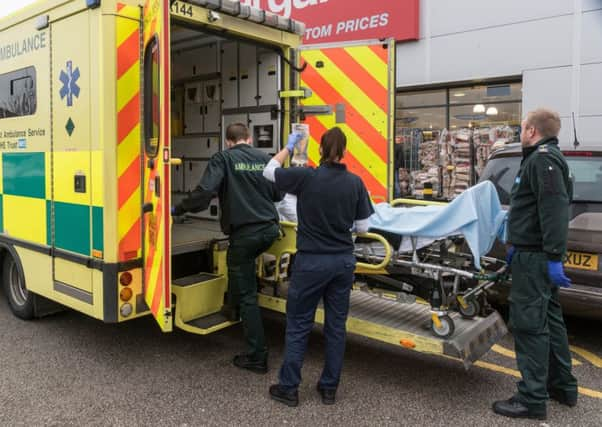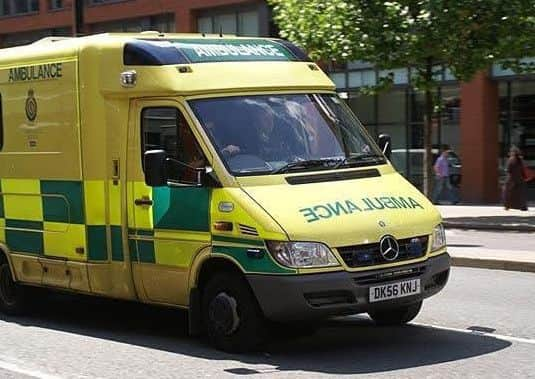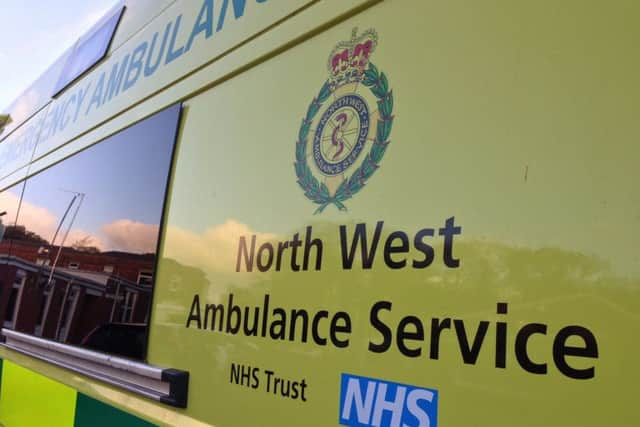North West Ambulance Service misses all targets


Paramedics were expected to reach 75 per cent of the most urgent 999 calls within eight minutes, but last year managed it just 68 per cent of the time.
North West Ambulance Service (NWAS) bosses did not foresee a huge rise in the number of calls, up 6.1 per cent against a projected two-and-a-half per cent rise, and also blamed lengthy handover times for the delays.
Advertisement
Hide AdAdvertisement
Hide AdA spokesman said: “NWAS continues to see high demand across all areas, including Lancashire. This demand means we take more people to hospital which then impacts on hospital emergency departments.


“This results in ambulance crews having to wait longer to handover patients into the care of hospital staff before they are able to get back out and respond to other emergencies.
“We are continuously striving to deliver the right care, in the right place, at the right time.
“More patients are now being clinically assessed over the phone by our specialist paramedics.
Advertisement
Hide AdAdvertisement
Hide Ad“This helps to reduce the number of ambulances dispatched, freeing them up for more serious emergencies, and the number of unnecessary journeys to hospital.


“We also do our best to treat patients at home wherever possible and ensure that only patients who need to be are taken to hospital.”
Directors at the North West Ambulance Trust were told at a recent meeting that failing to get to patients in a timely manner ends in ‘detrimental patient care’, an increase in complaints, damage to reputation, and ‘extended response times to emergency and urgent’ calls.
Paramedics were only able to reach 67.73 per cent of red one calls – where a patient is not breathing or their hard has stopped – within eight minutes, below the standard of 75 per cent and down from 75.56 per cent last year.
Advertisement
Hide AdAdvertisement
Hide AdThey got to 62.67 per cent of red two calls – still serious but less critical – within eight minutes, again below the 75 per cent standard and down from 71.57 per cent year-on-year.


“The headline figures demonstrate a challenging year in terms of both operation and financial performance,” the service’s annual report said. “While the trust has a strong track record of achieving financial targets, we were disappointed not to deliver the national performance targets for emergency responses in 2016/17.”
It added: “An increase in hospital handover times has impacted on the trust’s ability to achieve the national performance standards by reducing the amount of available resources.”
In April, paramedics took 16 minutes to reach 79-year-old Ruby Catlow, who accidentally set herself on fire with a cigarette on Blackpool’s Grange Park estate. She later died from her injuries.
Advertisement
Hide AdAdvertisement
Hide AdAmbulance bosses apologised and said it ‘allocated a resource as soon as one became available’ as it struggled to cope with demand.


And last June, a 91-year-old St Annes pensioner was left waiting for hours with a broken hip.
Her furious friend John Gregson, 76, said it ‘beggars believe’ the former Preston teacher faced a wait of five-and-a-half hour after tripping in her kitchen.
The length of time paramedics are left waiting at Blackpool Victoria Hospital’s A&E department has soared by 450 per cent since 2013/14, while breaches of handover times – waits of more than an hour – were reported 145 times in 2016, compared to just twice the year before.
Advertisement
Hide AdAdvertisement
Hide AdThe issue was reflected nationally as patient numbers increased, with all but one ambulance trust reporting a rise, and with the overall figure doubling in recent years.
And in January alone, paramedics spent the equivalent of 900 12-hour shifts waiting to hand patients over to hospital staff.
Last year, the GMB voiced its concern after claiming trolley logjams at A&E departments are keeping ambulances off the road and putting lives at risk.
Union officials said staff were at ‘breaking point’ as handover times rocketed. Regional organiser Lisa Ryan said: “Staff are now at breaking point, increasingly frustrated hanging around hospital corridors knowing that patients in the community are waiting for their help. “They should not be expected to look after patients in hospital corridors while people suffer in the street.”
Advertisement
Hide AdAdvertisement
Hide AdTim Bennett, the deputy chief executive at Blackpool Victoria Hospital, which has previously assigned nurses to A&E corridors to help deal with the high demand, said: “If you get a delay in patients being discharged, for whatever reason, it backs up.
“Eventually, it will manifest itself in a delay in A&E, and that delay will back up against because the ambulance crews won’t be able to handover as quickly.
“We got £1m worth of funding to do some redesign work in A&E, which will enable us to stream off the less urgent cases and get them seen more quickly.
“That will allow us to get the more serious cases in and handed over quicker.
Advertisement
Hide AdAdvertisement
Hide Ad“There are things we are doing and we hope that’ll be in place by next winter. It’s quite a lot to do when you’re talking about building works and changes within a department you can’t close as it’s operating 24/7.
“Trying to do any big redesign work in a short period of time is pretty complex, but we’ve got the money, so we’re optimistic we will be able to do something in time for winter, and that should reduce handover times.”
Funding is thought to be at risk because of the drop in response times, but an NWAS spokeswoman was unable to provide a figure when asked by email about the precise implications.
She confirmed the service saw a record number of patients last year – a total of 1,065,761 emergency incidents were logged – but said around 4,950 fewer patients were actually taken to hospital.
Advertisement
Hide AdAdvertisement
Hide AdAn extra 13,644 were dealt with by the Hear and Treat service, which uses telephone triage to assess 999 and 111 calls and often ends in a referral to an urgent care or walk-in centre, or even just medical advice.
And an extra 24,077 were dealt with by the See and Treat service, when a crew is dispatched but an alternative to hospital is instead judged to meet a patient’s needs. They can include community nursing teams, GPs, or the specialist falls service.
“We are continuously looking at ways we are able to deliver the right care, in the right place, at the right time,” the spokeswoman added.
“This will include more use of our services described above so that we are able to minimise conveyance to A&E when appropriate.
Advertisement
Hide AdAdvertisement
Hide Ad“This in turn will free up emergency ambulances to attend those most at need.”
She said the service is ‘currently advertising’ for paramedics and ambulance technicians, but did not say how many vacancies there were.
And she said the public should ‘please only use 999 in genuine emergencies’.
“If in doubt, call 111 for advice or you can go on to the NHS Choices website for further information,” she added.